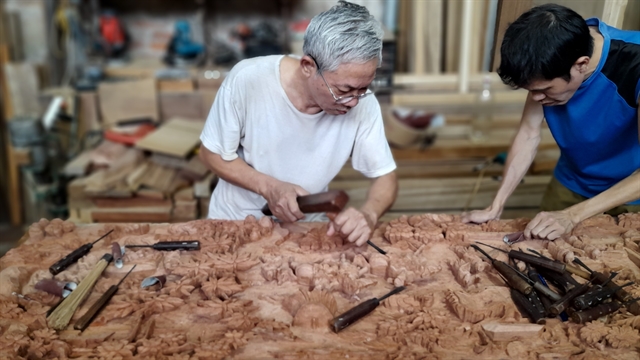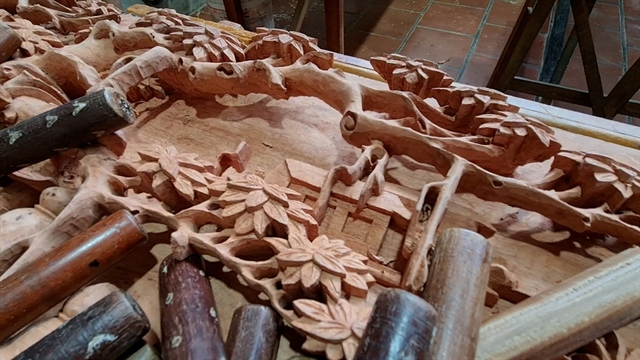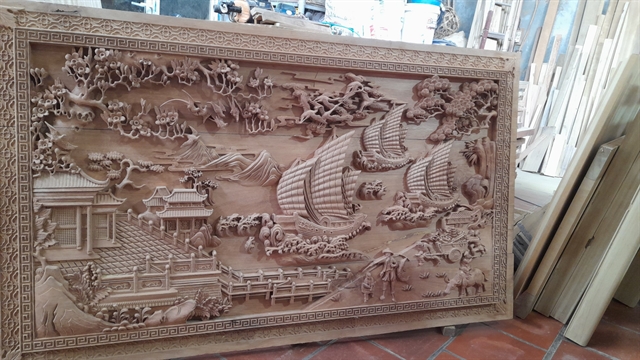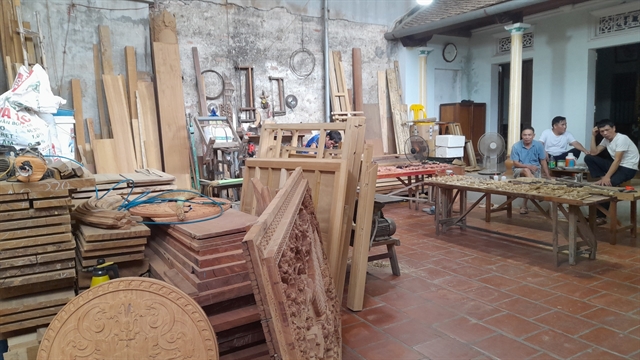 Sunday/Weekend
Sunday/Weekend

 |
| Artisan Nguyễn Quang Dô (left) carves a bas-relief with meticulous precision and attention to detail. — VNS Photo Thanh Nga |
By Thanh Nga
(Additional reporting by Lyly Cao and Kiều Trinh)
A mere 20km from the heart of Hà Nội lies Thượng Mạo Village in the outskirts district of Hà Đông. Renowned for its rich tradition of carpentry, this village has been thriving for centuries and continues to flourish as a prominent supplier of wooden products throughout the country.
We visited this craft village one sunny afternoon, where the air resonated with the symphony of wood shavings, the rhythmic tapping of chisels, and the bustling presence of lorries transporting timber to the village.
As we stepped foot into the village, the true beauty of the artisans' craftsmanship became apparent -- a testament to their unwavering dedication in creating tangible expressions of cultural heritage and history.
With their deft hands, the carpenters of Thượng Mạo contributed to the construction of numerous communal houses, pagodas, temples, and churches, all meticulously done in accordance with ancient architectural principles.
Some of these remarkable works have endured the test of time and remained intact to this day, including the Làng Đơ Communal House, Khương Thượng Communal House, Bình Đà Communal House, and La Tinh Communal House.
Across the ebb and flow of history, the essence of Thượng Mạo's carpentry has been faithfully passed down from generation to generation, preserving and showcasing the finest aspects of this craft village.
"Thượng Mạo Village has 570 households, 350 of them engaged in carpentry. In 2009, the Hà Nội People's Committee officially recognised our village as a craft village, and it holds a special place in our hearts as it is home to the temple worshipping the patron saint of the ancient craft. Every year, on the 11th day of the 10th lunar month, we gather for a commemorative ceremony," Nguyễn Quang Thoại, chairman of the Thượng Mạo Traditional Carpentry Village Association, told Việt Nam News.
 |
| Thượng Mạo craft village has 570 households, 350 of them engaged in carpentry. — VNS Photo Lyly Cao |
According to Thoại, in recent years, the village has expanded its production to meet the growing market demand. They have diversified their products to include altar items, beds, cabinets, tables, chairs, stairs, doors, and artistic wooden carvings.
Skilled workers have also been involved in sculpting large-scale projects both at home and abroad. The carpentry production has significantly improved the lives of the local people, with each worker earning an average income of VNĐ10 million (US$400) per month.
The process of creating a product involves several intricate stages. In the past, when manual labour was predominant, Thượng Mạo carpenters used rudimentary tools. However, with the advent of modern technology, most artisans have changed to machines. Cutting machines and electric planers have helped in increasing the workers' productivity and improved the quality of their products.
As someone who has dedicated their entire life to carpentry, Thoại understands the unique characteristics of the profession better than anyone else.
"Carpentry is a craft that demands meticulousness, diligence, as well as the innate talent and creativity of the craftsman. Each carpentry product goes through six main stages, including understanding the design drawings, wood preparation, wood cutting, rough part preparation, preliminary processing, and finishing. Every worker must be proficient in all six stages," he said.
 |
| Carving a bas-relief from sandalwood. VNS Photo Lyly Cao |
A distinctive feature of Thượng Mạo carpenters is that they exclusively work on customer orders, rather than engaging in mass production for general sale. This personalised approach ensures that each product is tailored to the specific requirements and preferences of the customer.
We visited the home of artisan Nguyễn Quang Dô, a master renowned for his exquisite wood carvings, boasting over 50 years of experience in the craft. Dô is celebrated for his ability to transform wood into captivating pieces of art.
Upon our arrival, we found Dô engrossed in his work, delicately carving a bas-relief from sandalwood.
 |
| A bas-relief by artisan Nguyễn Quang Dô. — VNS Photo Thanh Nga |
According to Dô, the art of carving demands not only skilful hands, but also a thoughtful mind that can infuse life and soul into a wooden slab. To achieve a satisfactory outcome, a careful selection of high-quality wood is essential, and various techniques are employed during the chiselling process.
Additionally, the artisan must possess a mindset that ensures each individual piece is harmoniously balanced, not necessarily adhering to strict proportions. The assembly requires solidity to ensure that the intricate patterns are seamlessly integrated, with the lines etched deeply.
Manual chiselling is arduous and necessitates a wide range of techniques, but it results in a more sought-after product. The chiseller must remain persistent, treating each piece as a cherished creation.
"The pursuit of beauty is a challenging endeavour. As someone who has devoted themselves to this craft, I must have love for it. With love, all difficulties can be overcome effortlessly," Dô said, reflecting on his lifelong passion for the art of carving.
 |
| Most of the carpentry work occurs within households, there is a shortage of dedicated production areas. — VNS Photo Thanh Nga |
Developing sustainably
The economic transformation brought about by traditional occupations in Thượng Mạo Village is undeniable. However, alongside this economic development, the craft village faces challenges such as environmental pollution and a lack of production space.
One of the major difficulties lies in the village's infrastructure, particularly the narrow road network that fails to adequately support transportation and production needs. Moreover, since most of the production process occurs within households, there is a shortage of land for large workshops.
"Given that our products are made from wood and go through various stages such as sawing, planing, chiselling, and painting, workers are exposed to dirt, noise, and chemical odours emanating from the painting and polishing processes. As they work within homes, their health is directly affected by this source of pollution," Thoại said.
Consequently, the people of Thượng Mạo are seeking the authorities' attention and support. They want to have an industrial cluster planned for the craft village, which would create better conditions for preserving their traditional occupations while ensuring economic development and environmental protection.
 |
| Thượng Mạo Village is located within Phú Lương Ward, Hà Đông District, Hà Nội. — VNS Photo Thanh Nga |
By addressing these challenges and implementing specific solutions, the craft village can thrive sustainably while preserving its cultural heritage and promoting the wellbeing of its residents. VNS




